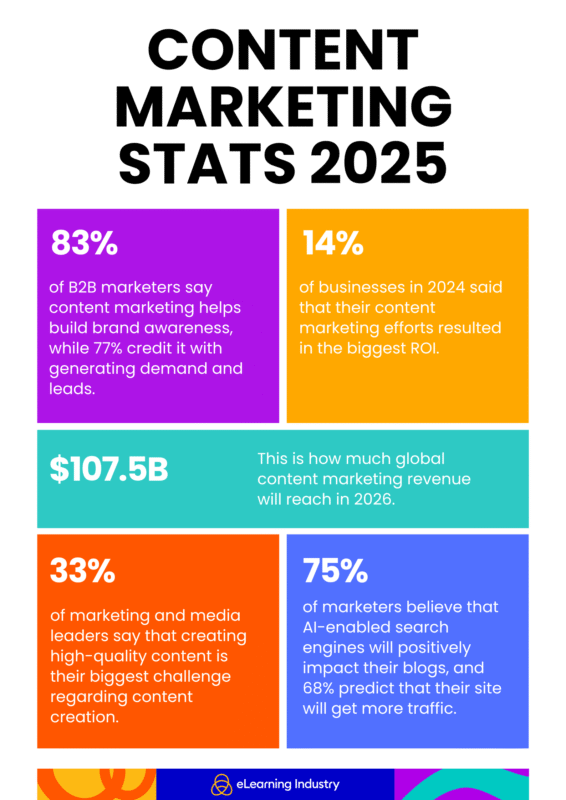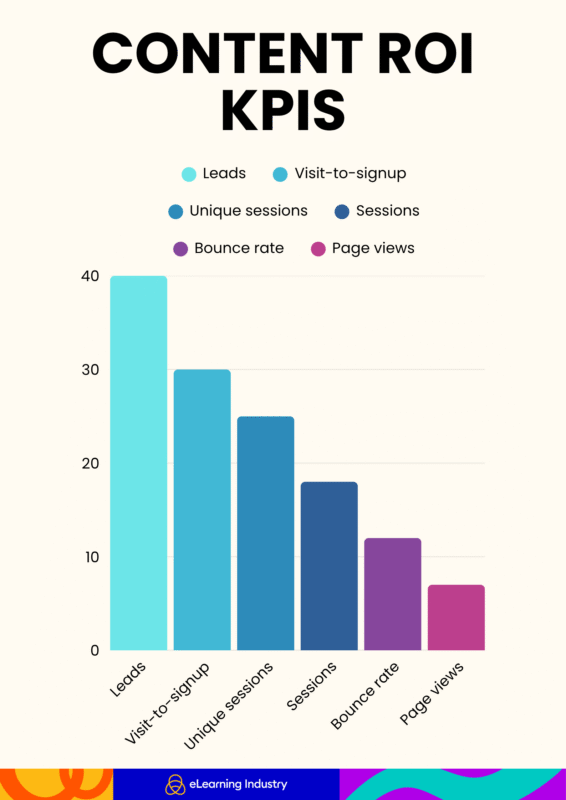Why Content Is A Growth Hack, Not Just An Activity
Strategic marketing for CEOs means aligning content, data, and distribution to drive measurable growth, including leads and revenue. Content is a huge part of any company's marketing initiatives, as it helps establish your brand voice and thought leadership. Think of content as any other type of media you're using to promote your business. You're probably focusing a lot on social media and online ads, right? Why not show the same affection to blog content? While it may not be among the top business growth strategies for a CEO, it's your responsibility to ensure your content style aligns with your business values.
To reach content-driven growth, you should find various ways to leverage high-quality and educational content. Publishing consistently powerful content on your own and third-party platforms helps you build trust and loyalty among your audience. Potential buyers perceive you as an industry expert and are more likely to purchase your solutions. In fact, content marketing revenue is expected to reach $107.5 billion in 2026.
Let's see how you can create an effective content marketing roadmap that will turn into a B2B demand generation strategy.
In This Guide, You Will Find...
- A CEO's Role In Strategic Marketing
- A Strategic Content Marketing Strategy Guide For CEOs
- Metrics That Matter To The C-Suite
- Strategic Content Marketing Mistakes CEOs Make
- Examples Of Companies That Shifted From Content Quantity To Content ROI Focus
A CEO's Role In Strategic Marketing
According to McKinsey, 83% of CEOs believe marketing to be a potential growth hack. As a CEO, you're not only calling the shots or giving your marketing team the green light for campaigns and strategies. You should be part of the marketing and communications plan. For starters, you must ensure your B2B content funnel is aligned with your buyers' journey and your prospects' needs and challenges. Consistency and coherence should always be your driving forces.
Additionally, SaaS growth strategies rooted in marketing require your own promotion, too. Since you are the face and voice of a brand, you should strengthen your personal marketing. Many CEOs increase their online presence by posting regularly on LinkedIn and other social media platforms. Video marketing helps immensely with content-led demand generation, as 93% of marketers report a positive ROI from leveraging videos.
In other words, a CEO makes content-related decisions based on the current and future trends, ensuring your brand's voice is maintained across all platforms. This often includes participating in awards like eLI's Top List Awards that crown the best vendors in eLearning and HR tech.

A Strategic Content Marketing Strategy Guide For CEOs
-
Define KPIs
Tracking your measurable goals is monumental in any marketing plan. Do you want to create brand awareness, generate new leads, or establish yourself as a thought leader? Based on your main goal, you will then choose your KPIs. Every piece of content you create should be perfectly aligned with your business goals. For example, if you want to gather leads, every article, social media post, and video should prompt people to sign up using a form.
Most CEOs usually measure KPIs like customer acquisition cost (CAC) and conversion rate. These are the main content marketing metrics that matter if you want to ensure your content increases your company's revenue. Remember that while content takes effort and time to deliver results, it can reduce your CAC dramatically. Make sure to leverage SEO and link building services to make your content effective.
-
Audit Your Current Content
You can't build an effective strategic marketing workflow for CEOs unless you audit your website's content. This is not a technical SEO audit, as your goal isn't to analyze the technical aspect of your posts. You want to check the SEO performance of your current content and strengthen it by doing extra keyword research, filling in content gaps, updating outdated articles, and removing old, bad-quality content. All these improvements elevate the overall website user experience.
Additionally, turning content into revenue requires you to tackle subjects that are in demand and aligned with your current business goals and priorities. This is especially useful if you are going through a rebrand or releasing a new product. Lastly, your audit will help you discover pages and articles that bring in significant traffic but aren't optimized for marketing purposes. Therefore, you can add fresh CTAs.
During this process, you may need to work with an agency that will help you conduct an in-depth SEO audit.
-
Set Buyer Personas
As a CEO, you play a big role in setting up your company's software sales strategy, including any content activities. A content-to-revenue strategy, though, needs to be directed specifically to your buyer personas. Who are they, and what do they need? Which pain points do they need fixed? These questions guide you to identify them and create content that resonates deeply. Also, you must understand how they like to consume content and which platforms they use daily. For example, an HR buyer may be more likely to click on an email rather than read an Instagram post.
That's why you should know who you're talking to and invest in the right solutions. If email is your go-to option, you may need to promote your brand through third-party publishers who are trustworthy and influential in your industry. An exclusive email blast or featured placement from them can generate more leads than any viral social media post.
-
Create Valuable Content
Now you're ready to move on to the next part of your SEO content strategy, which is creating the right content. It's easier to do so once you know who you're targeting and what your business goals are. Start by doing keyword research to identify which phrases are aligned with your goals and have high intent. Choose long-tail keywords without very high traffic, as it's harder to rank and surpass already ranking articles. Also, you may focus on the content your SEO audit showed has yet to be tackled by your key competitors.
However, content-led demand generation depends on a masterful balance of educational and promotional content. No article should be a constant advertisement for your services. You should include links and CTAs cleverly whenever you can. While you want to get some valuable clicks to your product pages, you don't want readers to feel that you only want their money.
-
Distribute Content Wisely
Apart from posting your content on your website and social media accounts, you should leverage other effective avenues. Many B2B companies also send email notifications, including their latest article releases. eLearning Industry does the same thing. For example, once a week, we send our subscribers an email with the latest eBook releases to keep them updated. You may also choose to use banner ads to promote your content both on your website and in other publications.
Additionally, you can use content syndication platforms to republish your content and maximize your reach. Strategic marketing for CEOs tries to create a holistic approach to generate leads. eLI is such a platform and publishes content from various companies and individual thought leaders who simply want to establish authority in their niche. So, this strategy can help not only your company's credibility but also build up your influence.
-
Track Your Metrics
Like you do with lead gen campaigns, you should always measure the success of your content. For starters, use Google Analytics to check how much traffic your content gets and pay attention to time on page, bounce rate, and social shares to understand how engaging your content is. But these metrics don't show you how sales-effective your content is. For this reason, keep track of lead conversion rates and sales conversion rates. How many people filled out a form to download your eBooks or subscribe to your webinars?
Moreover, use SEO tools like Ahrefs or Semrush to track your content's ranking. These tools will highlight improvement opportunities. Lastly, CEO marketing insights include the ROI of your content marketing initiatives. You usually count the resources spent to create and promote your content in comparison to the leads you generated. This way, you understand whether your approach is cost-effective.
Metrics That Matter To The C-Suite

-
Lead Quality
Executives don't just want to see big numbers. They want to see results that actually convert. A thousand unqualified leads mean little if none of them become customers. The focus here is on quality. Are the leads the right fit, do they have buying intent, and do they align with your ideal customer profile? High-quality leads are more likely to move through the funnel efficiently and bring real revenue impact, turning content into revenue rather than just clicks and impressions.
-
Pipeline Influence And Deal Acceleration
This is all about understanding how marketing activities help move deals forward. Instead of just measuring how many leads are generated, the C-suite wants to see how strategic marketing for CEOs contributes to effective sales pipeline management by speeding up the sales cycle and shortening the time from first contact to closed deal. Pipeline influence shows how marketing touches, like webinars, ads, or content, help push a deal along or expand its value. Essentially, it's about demonstrating how marketing helps sales sell faster and bigger.
-
ROI Attribution
Here, it's all about proving value. Leaders want to know which marketing efforts actually produce revenue. A strong marketing ROI framework connects the dots, showing how specific campaigns (like a LinkedIn ad series or a trade show) translate into real business outcomes. By tracking these results using key SaaS metrics, executives can make smarter investment decisions: keep funding what works, and cut what doesn't. This approach also highlights areas where marketing can optimize spend and improve performance over time.
-
Brand Authority Indicators
This metric reflects how strong and credible your brand appears in the market. Share of voice shows how much your brand is being talked about compared to competitors. Relevant backlinks and citations indicate that other credible sources are referencing your content, a sign of trust and authority. For the C-suite, these are strategic indicators of long-term brand strength and market positioning, not just vanity numbers. Also, they play a key role in a content-to-revenue strategy that turns brand visibility into measurable business impact.
Strategic Content Marketing Mistakes CEOs Make
-
Treat Content As "Fluff"
You will never achieve content-driven growth if you treat it as something to fill your website with. It takes time to create valuable and insightful pieces of content, and that's why many CEOs advise their team members to use ChatGPT to create generic content quickly. This practice will never win you AI mentions and citations. You need to follow Google EEAT practices to appear as an expert in your industry.
-
Measure The Wrong Things
Vanity metrics provide you with a wrong sense of success. Who cares if you have amazing website traffic but very low engagement? If you want to focus on strategic marketing for CEOs, you should pay attention to actually valuable metrics, including engagement rates, bounce rates, conversion rates, and time on page. These are the ones that will help your growth hacking strategies take off.
-
Focus On Volume
The more content you produce, the more engaged your audience is, right? Well, not really. When you produce content in mass, you fail to go deep. Instead, you stay on the surface, which provides no actual value to your audience. It's not only about writing long reads but also about tackling your buyer personas' needs and challenges. Yes, ChatGPT can write long articles in minutes, but can it make each one personal? We would heavily argue this.
-
Not Highlighting Solutions
It's understandable that you are proud of your product's amazing features. However, focusing on features through your content isn't in the strategic marketing for CEOs playbook. Why? Many clients aren't as tech-savvy as you think. They want to see how this wonderful feature translates into benefits and actions. So, focus on the outcomes, not the features.
Examples Of Companies That Shifted From Content Quantity To Content ROI Focus
1. Quantic School Of Business And Technology
They achieved a remarkable 29x Return On Investment (ROI) by shifting from a content quantity approach to a strategic content-to-revenue strategy. This transformation was driven by aligning marketing efforts with business goals and implementing a comprehensive strategic marketing plan. Here are a few things they did.
-
Keyword Optimization For Course Offerings
Quantic identified and targeted specific keywords related to their MBA and Executive MBA programs. By optimizing content around these keywords, they increased organic traffic to their site, leading to a significant rise in conversions.
- Enhanced User Experience And Conversion Pathways
The company improved its website's user experience by streamlining navigation and creating clear conversion pathways. This made it easier for prospective students to find information and apply, thereby increasing the likelihood of conversion.
- Data-Driven Content Creation
Quantic utilized data analytics to understand user behavior and preferences. This insight informed the creation of content that resonated with their audience, further driving engagement and conversions.
2. Headway
This EdTech company enhanced its ad performance by 40% by leveraging AI tools like Midjourney and HeyGen. By taking a strategic marketing for CEOs approach, they were able to produce engaging video ads efficiently, leading to a substantial increase in user sign-ups and demonstrating the value of intelligent content creation in achieving business goals. Here's what they did.
-
Leveraged AI For Ad Creation
Used tools like Midjourney and HeyGen to produce engaging video ads, boosting ROI by 40% and generating billions of impressions.
-
Aligned Marketing With Business Goals
Integrated AI-driven marketing efforts with company objectives, ensuring campaigns supported strategic growth.
-
Ran Targeted Demand Generation Campaigns
Created dynamic, attention-grabbing ads (e.g., animating historical figures) that increased user signups and overall engagement.
3. Grey Matter
This HR software provider generated a $6.5 million pipeline and $1.6 million in closed revenue within two months by overhauling their digital strategy. Through targeted ads, data-driven tactics, and a fresh customer acquisition strategy, they reshaped their market presence and achieved significant growth, underscoring the impact of strategic content and marketing in HR technology. Here's their successful strategy.
-
Optimized Digital Campaigns For Revenue
Redesigned ads and content to directly support pipeline growth, generating $6.5 million in opportunities and $1.6 million in closed revenue within two months.
-
Developed Thought Leadership Content
Produced high-value articles, whitepapers, and case studies that positioned Grey Matter as an industry authority while nurturing leads.
-
Aligned Marketing With Business Goals
Integrated content and campaigns into the overall customer acquisition strategy, ensuring every marketing effort contributed to measurable growth.
Key Takeaway
Content is far more than a marketing activity. It is a growth engine that drives measurable business outcomes. Strategic marketing for CEOs requires aligning content initiatives with clear business objectives, ensuring every piece of content contributes to lead generation, pipeline acceleration, and brand authority. By leveraging a marketing ROI framework, executives can track the direct impact of content on revenue, optimizing spend and prioritizing strategies that deliver tangible results.
Furthermore, participation in initiatives such as the AI Excellence Awards and other similar instances underscores the value of innovative content strategies and thought leadership in today's competitive field. CEOs who prioritize a strategic content-to-revenue approach not only enhance their brand visibility but also foster trust, loyalty, and authority. Ultimately, content is a measurable growth hack when guided by insight, consistency, and a results-focused mindset.
FAQ
Content is a growth hack because it drives measurable business outcomes by aligning with clear objectives, building trust, and accelerating the sales pipeline.
CEOs should actively participate in content marketing by defining KPIs, aligning content with business goals, and maintaining the brand's voice across platforms.
Track metrics like lead conversion rates, sales conversion rates, time on page, bounce rate, and social shares to assess content performance.
Mistakes include treating content as filler, focusing on vanity metrics, prioritizing volume over quality, and neglecting to highlight solutions.
Conduct regular content audits to identify top-performing content, update outdated articles, fill content gaps, and optimize for SEO.
Understanding buyer personas helps create targeted content that addresses specific needs and preferences, enhancing engagement and conversions.

